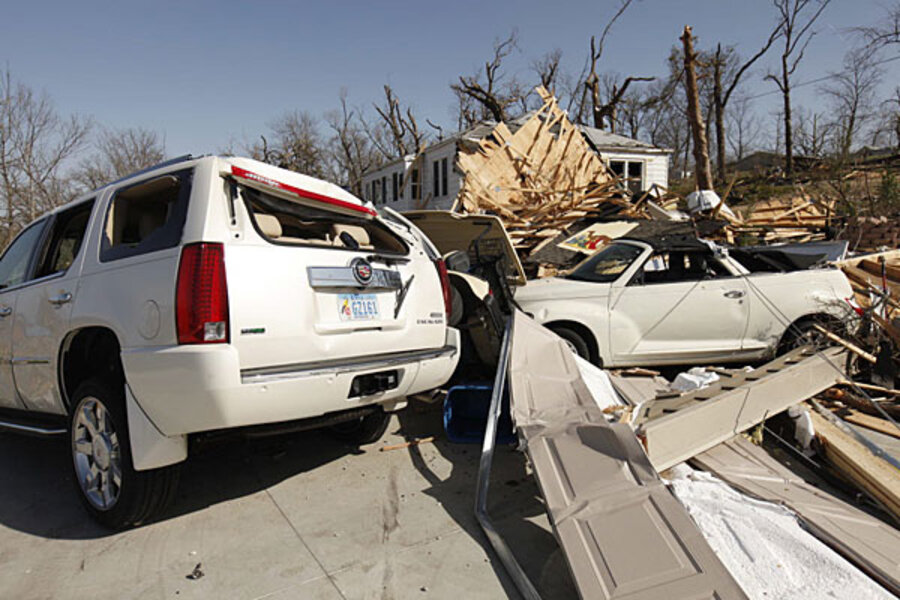Nine dead as tornadoes rip from Branson, Missouri, up to Illinois
Loading...
| Atlanta
With parts of Branson, Mo.'s, historic downtown in tatters from a tornado and at least six dead in Illinois, Americans in "hurricane alley" and beyond are wondering whether early signs of a stormy spring could lead to the same kind of devastation that leveled parts of the Midwest and South in 2011.
Patterns of unseasonably warm weather grinding against late-winter cold blasts have already led to more than 100 tornadoes across the US this year alone, with 16 sighted late Tuesday into early Wednesday across a wide swath of the country spanning from Illinois to Kansas. The system was moving across Kentucky early Wednesday afternoon, with one potential twister reported near Louisville.
So far, at least nine fatalities have been reported from the tornado outbreak in Missouri and Illinois, with historic buildings in the country music mecca of Branson, Mo., being particularly hard-hit as one twister hopped through the middle of town. Six people were killed and hundreds injured in Harrisburg, Ill., where as many as 200 homes were damaged or destroyed and where winds flipped 18-wheelers and brought down trees. The town of Harveyville, Kan., saw damage to 40 percent of its homes and buildings, and Gov. Sam Brownback issued a state of emergency.
Tornadoes are notably difficult to predict, but broader weather patterns are indicating that Americans in storm-prone parts of the country need to stay aware and tuned in to muscular fronts rumbling above, forecasters say. Last year's historic tornado season – which left 550 people dead, 5,400 injured, and parts of major cities destroyed across a slew of Southern and Midwestern states – had a slow start, with most of the damage coming in April. In contrast, 95 tornadoes struck in January 2012 alone, compared with 16 a year earlier. Nebraska on Tuesday saw its first February tornado strike in 62 years.
Forecasters, however, are not predicting a repeat of last year's destruction, a fact that has less to do with weather patterns than climatological odds. While this week's system was large, powerful, and destructive, it was not atypical for this time of year, they say.
“The best we can say at this point is we're going to see an increase in severe weather just based on climatology into March and April,” says Greg Carbin, a forecaster with the Storm Prediction Center in Norman, Okla. “Whether that's going to be anything like last year is uncertain, but the amount of activity we saw last year and the intensity of some of those storms would be difficult to repeat. It's not that nature can't do that, but last year was out on the edge for what nature can do and set the bar as far as widespread events and amount of damage.”
However, there is concern among meteorologists that this season could be marked with unusual tornado strikes and intensity. "As we head toward the spring season our expectations are that 2012 will favor above-normal tornado numbers once again, primarily due to La Niña," meteorologist Jeff Johnson said in a blog post. He is chief science officer at Telvent, which provides weather forecasting to companies and cities.
The system that struck the Midwest late Tuesday and early Wednesday began as a low-pressure front cascading down from the Rockies, clashing with lingering warm, moist air to the east. The system rumbled across the country's midsection, spawning intense thunderstorms and powerful twisters.
In Branson, home to Dolly Parton's Dixie Stampede and a host of other country-music-related tourist destinations, the twister seemed to descend with a purpose, locals say.
“The theater next to me kind of exploded. It went everywhere. The hotels on the two sides of me lost their roofs. Power lines are down. Windows are blown out,” John Moore, a diner owner, told the Associated Press. “There’s major, major destruction. There has to be millions of dollars of damage all down the strip.”
Storms also ripped across northern Arkansas, with golf-ball-size hail crashing into northeastern parts of the state. But scenes from Harrisburg in southern Illinois were perhaps the most stunning, as entire neighborhoods lay smashed by tornadoes in scenes uncomfortably reminiscent of last year's tornado outbreaks in Joplin, Mo., and the Alabama cities of Tuscaloosa and Birmingham.
Tornado watches remained in effect in central Kentucky, where officials in Hardin County, just southwest of Louisville, are investigating reports of a possible tornado. Homes and farm buildings sustained heavy damage in the area, and some livestock were reported killed.







